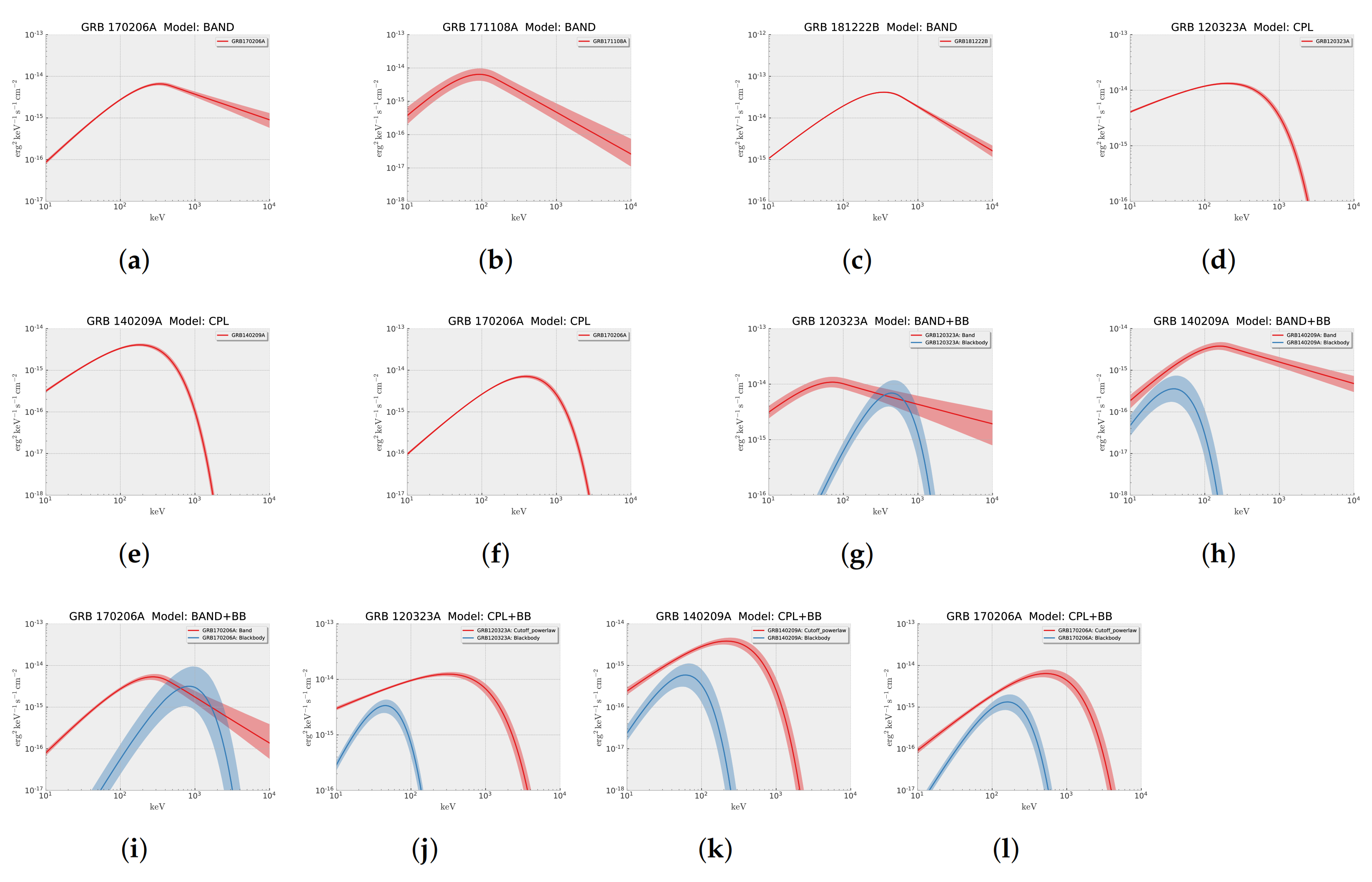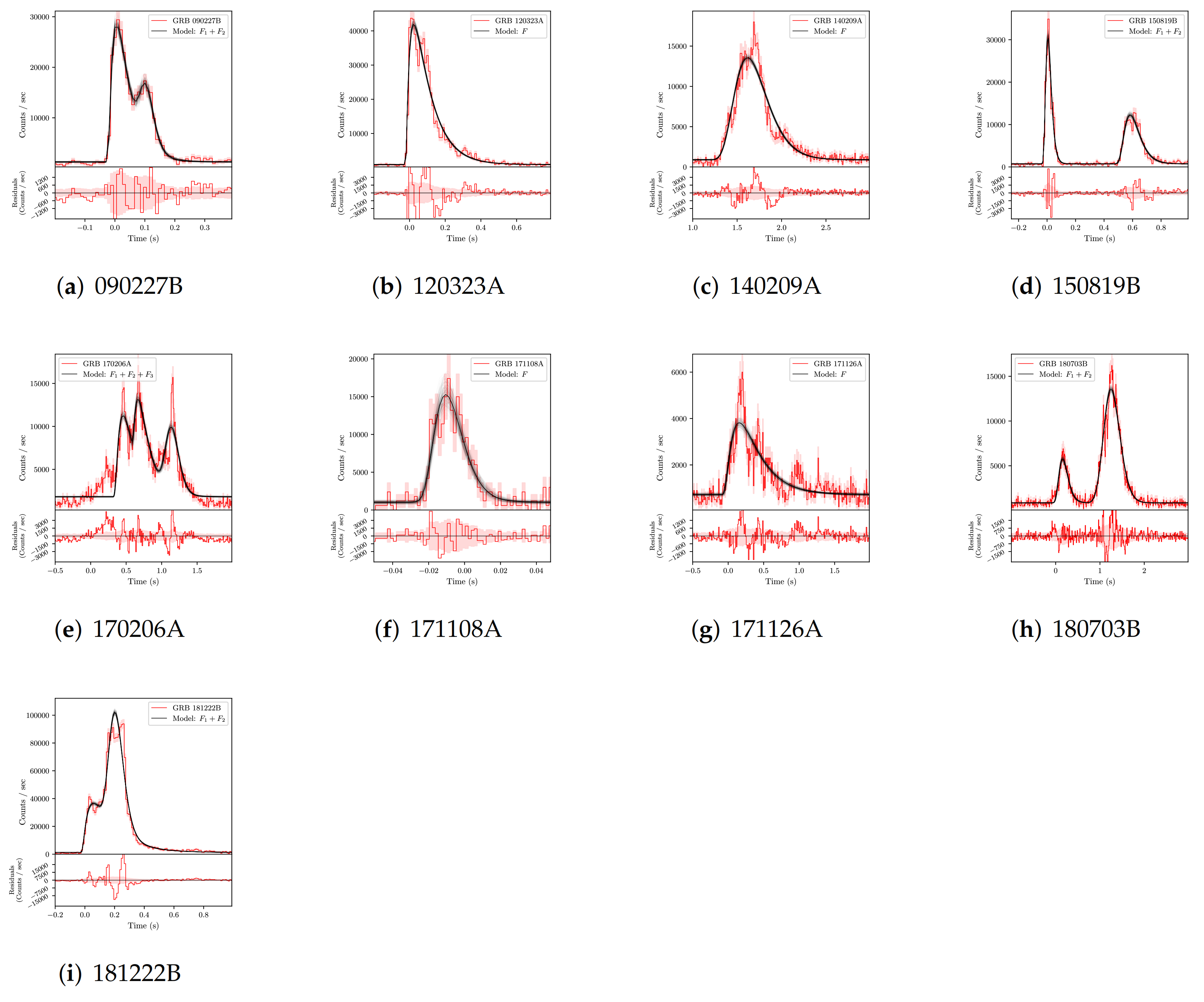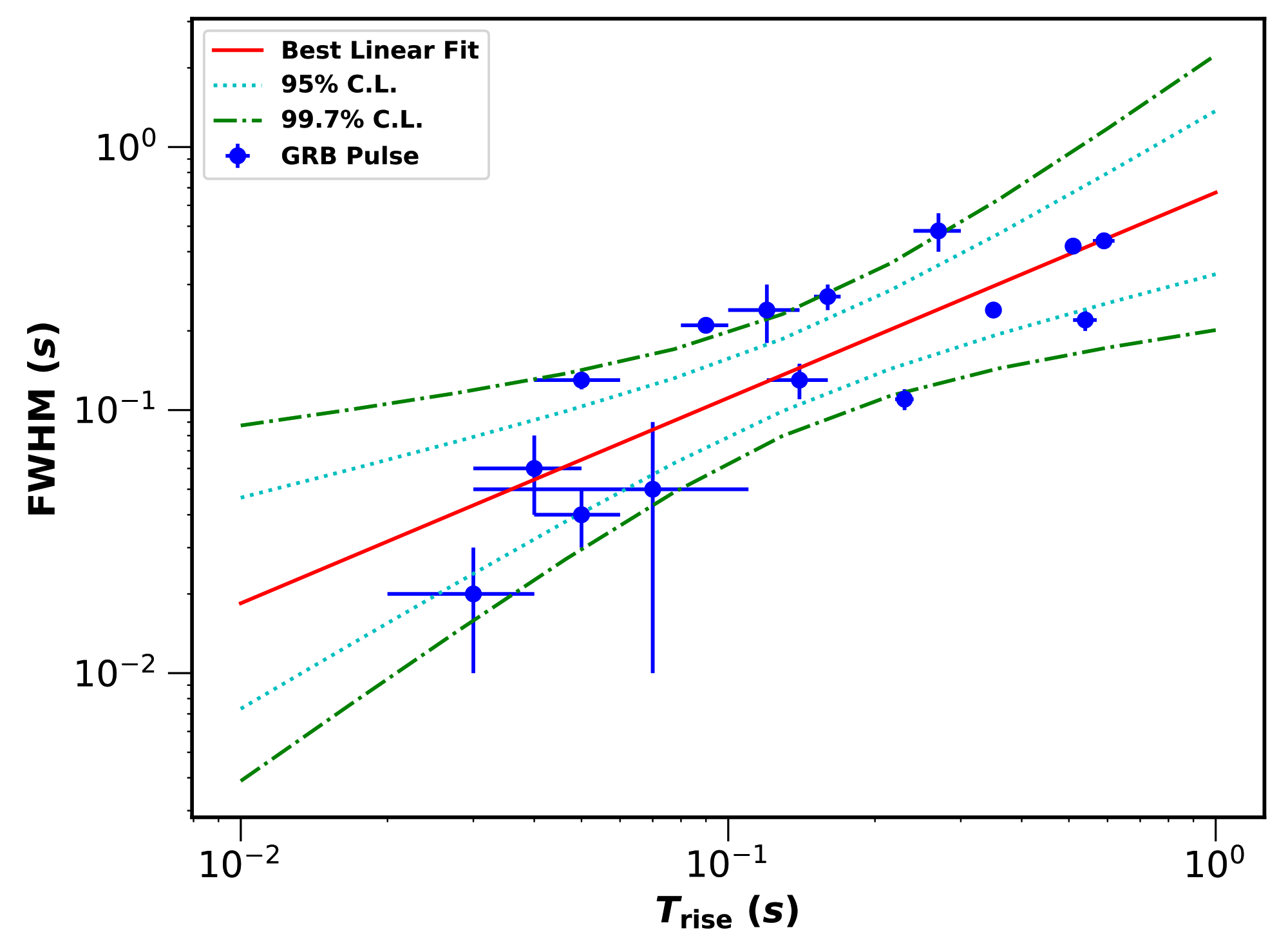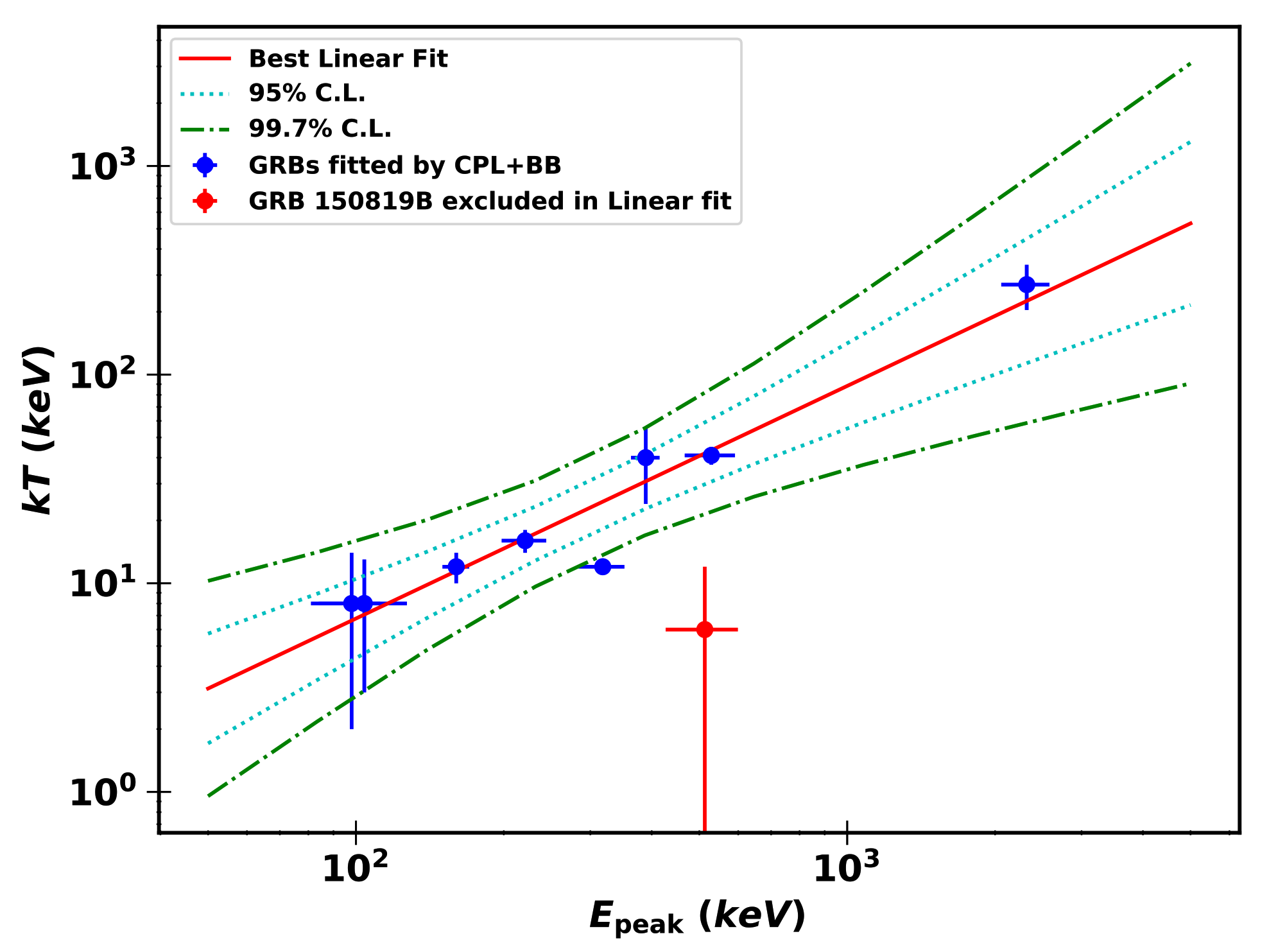A Comprehensive Study of Bright Fermi-GBM Short Gamma-ray Bursts: I. Multi-Pulse Lightcurves and Multi-Component Spectra
Abstract
:1. Introduction
2. Data Analysis
2.1. Sample Selection
2.2. Method
2.2.1. Lightcurve Fitting
2.2.2. Spectral Energy Distribution Fitting
3. Result
3.1. Multiple Pulses
| GRB | Models | ||||||||
|---|---|---|---|---|---|---|---|---|---|
(s) | (s) | (s) | (s) | (s) | (s) | (s) | (s) | (s) | |
| 090227B | - | - | - | ||||||
| 120323A | - | - | - | - | - | - | |||
| 140209A | - | - | - | - | - | - | |||
| 150819B | - | - | - | ||||||
| 170206A | |||||||||
| 171108A | - | - | - | - | - | - | |||
| 171126A | - | - | - | - | - | - | |||
| 180703B | - | - | - | ||||||
| 181222B | - | - | - | ||||||
3.2. Multiple Spectral Components
- For GRB 090227B, CPL, BAND + BB and CPL + BB models are the compared models.
- For GRB 120323A, CPL + BB model is the best-fit model.
- For GRB 140209A, BAND and BAND + BB models are the compared models.
- For GRB 150819B, CPL and CPL + BB models are the compared models.
- For GRB 170206A, CPL + BB model is the best-fit model.
- For GRB 171108A, BAND, CPL and CPL + BB models are the compared models.
- For GRB 171126A, BAND and CPL models are the compared models.
- For GRB 180703B, BAND, CPL and CPL + BB models are the comared models.
- For GRB 181222B, BAND model is the best model.
(keV) | (keV) | |||||
|---|---|---|---|---|---|---|
| 090227B | BAND | 1692 | - | |||
| CPL | 1517 | - | - | |||
| BAND + BB | 1522 | |||||
| CPL + BB | 1522 | - | ||||
| 120323A | BAND | 2151 | - | |||
| CPL | 2310 | - | - | |||
| BAND + BB | 2158 | |||||
| CPL + BB | 2097 | - | ||||
| 140209A | BAND | 3194 | - | |||
| CPL | 3248 | - | - | |||
| BAND + BB | 3191 | |||||
| CPL + BB | 3220 | - | ||||
| 150819B | BAND | 2670 | - | |||
| CPL | 2663 | - | - | |||
| BAND + BB | 2672 | |||||
| CPL + BB | 2665 | - | ||||
| 170206A | BAND | 3056 | - | |||
| CPL | 3054 | - | - | |||
| BAND + BB | 3062 | |||||
| CPL + BB | 3048 | - | ||||
| 171108A | BAND | 6 | - | |||
| CPL | 2 | - | - | |||
| BAND + BB | 12 | |||||
| CPL + BB | 7 | - | ||||
| 171126A | BAND | 2988 | - | |||
| CPL | 2989 | - | - | |||
| BAND + BB | 2999 | |||||
| CPL + BB | 2995 | - | ||||
| 180703B | BAND | 3482 | - | |||
| CPL | 3481 | - | - | |||
| BAND + BB | 3487 | |||||
| CPL + BB | 3483 | - | ||||
| 181222B | BAND | 2677 | - | |||
| CPL | 2719 | - | - | |||
| BAND + BB | 2687 | |||||
| CPL + BB | 2721 | - |

4. Discussion
4.1. Bias on the Transition Process of SGRBs
4.2. Implications for the Simultaneous Thermal and Non-Thermal Spectral Components
5. Summary and Conclusions
Author Contributions
Funding
Institutional Review Board Statement
Informed Consent Statement
Data Availability Statement
Conflicts of Interest
References
- Abbott, B.P.; Abbott, R.; Abbott, T.D.; Acernese, F.; Ackley, K.; Adams, C.; Adams, T.; Addesso, P.; Adhikari, R.X.; Adya, V.B.; et al. Gravitational Waves and Gamma-Rays from a Binary Neutron Star Merger: GW170817 and GRB 170817A. ApJL 2017, 848, L13. [Google Scholar] [CrossRef]
- Duffell, P.C.; Quataert, E.; Kasen, D.; Klion, H. Jet Dynamics in Compact Object Mergers: GW170817 Likely Had a Successful Jet. ApJ 2018, 866, 3. [Google Scholar] [CrossRef] [Green Version]
- Mooley, K.P.; Deller, A.T.; Gottlieb, O.; Nakar, E.; Hallinan, G.; Bourke, S.; Frail, D.A.; Horesh, A.; Corsi, A.; Hotokezaka, K. Superluminal motion of a relativistic jet in the neutron-star merger GW170817. Nature 2018, 561, 355. [Google Scholar] [CrossRef] [PubMed]
- Mooley, K.P.; Frail, D.A.; Dobie, D.; Lenc, E.; Corsi, A.; De, K.; Nayana, A.J.; Makhathini, S.; Heywood, I.; Murphy, T.; et al. A Strong Jet Signature in the Late-time Light Curve of GW170817. ApJL 2018, 868, L11. [Google Scholar] [CrossRef] [Green Version]
- Alexander, K.D.; Margutti, R.; Blanchard, P.K.; Fong, W.; Berger, E.; Hajela, A.; Eftekhari, T.; Chornock, R.; Cowperthwaite, P.S.; Giannios, D.; et al. A Decline in the X-ray through Radio Emission from GW170817 Continues to Support an Off-axis Structured Jet. ApJL 2018, 863, L18. [Google Scholar] [CrossRef] [Green Version]
- Granot, J.; Gill, R.; Guetta, D.; De Colle, F. Off-axis emission of short GRB jets from double neutron star mergers and GRB 170817A. MNRAS 2018, 481, 1597. [Google Scholar] [CrossRef] [Green Version]
- Kocevski, D.; Ryde, F.; Liang, E. Search for Relativistic Curvature Effects in Gamma-Ray Burst Pulses. ApJ 2003, 596, 389. [Google Scholar] [CrossRef]
- Lu, R.-J.; Qin, Y.-P.; Yi, T.-F. The Relationship between the Rise Width and the Full Width of γ-ray Burst Pulses and Its Implications. CHJAA 2006, 6, 52. [Google Scholar] [CrossRef]
- Peng, Z.Y.; Zhao, X.H.; Yin, Y.; Bao, Y.Y.; Ma, L. Energy-dependent Gamma-Ray Burst Pulse Width Due to the Curvature Effect and Intrinsic Band Spectrum. ApJ 2012, 752, 132. [Google Scholar] [CrossRef] [Green Version]
- Band, D.; Matteson, J.; Ford, L.; Schaefer, B.; Palmer, D.; Teegarden, B.; Cline, T.; Briggs, M.; Paciesas, W.; Pendleton, G.; et al. BATSE Observations of Gamma-ray Burst Spectra. I. Spectral Diversity. ApJ 1993, 413, 281. [Google Scholar] [CrossRef]
- Guiriec, S.; Daigne, F.; Hascoët, R.; Vianello, G.; Ryde, F.; Mochkovitch, R.; Kouveliotou, C.; Xiong, S.; Bhat, P.N.; Foley, S.; et al. Evidence for a Photospheric Component in the Prompt Emission of the Short GRB 120323A and Its Effects on the GRB Hardness-Luminosity Relation. ApJ 2013, 770, 32. [Google Scholar] [CrossRef]
- Zhao, P.-W.; Tang, Q.-W.; Zou, Y.-C.; Wang, K. Detection of Prompt Fast-Variable Thermal Spectral Component in Multi-Pulse Short Gamma-ray Burst 170206A. arXiv 2021, arXiv:2201.00642. [Google Scholar]
- Iyyani, S.; Sharma, V. Study of the Prompt Emission of Short Gamma-Ray Bursts Using a Multicolor Blackbody: A Clue to the Viewing Angle. ApJS 2021, 255, 25. [Google Scholar] [CrossRef]
- Paynter, J.; Webster, R.; Thrane, E. Evidence for an intermediate-mass black hole from a gravitationally lensed Gamma-ray Burst. Nat. Astron. 2021, 5, 560. [Google Scholar] [CrossRef]
- Norris, J.P.; Bonnell, J.T.; Kazanas, D.; Scargle, J.D.; Hakkila, J.; Giblin, T.W. Long-Lag, Wide-Pulse Gamma-Ray Bursts. ApJ 2005, 627, 324. [Google Scholar] [CrossRef] [Green Version]
- Schwarz, G. Estimating the Dimension of a Model. Ann. Stat. 1978, 6, 461. [Google Scholar] [CrossRef]
- Vianello, G.; Lauer, R.J.; Younk, P.; Tibaldo, L.; Burgess, J.M.; Ayala, H.; Harding, P.; Hui, M.; Omodei, N.; Zhou, H. The Multi-Mission Maximum Likelihood framework (3ML). arXiv 2015, arXiv:1507.08343. [Google Scholar]
- Newton, R.R.; Rudestam, K.E. Your Statistical Consultant: Answers to Your Data Analysis Questions; Sage Publications: Thousand Oaks, CA, USA, 1999. [Google Scholar]
- Kass, R.; Raftery, A. Bayes Factors. J. Am. Stat. Assoc. 1995, 90, 773. [Google Scholar] [CrossRef]
- Zhang, B.-B.; Zhang, B.; Castro-Tirado, A.J.; Dai, Z.G.; Tam, P.-H.T.; Wang, X.-Y.; Hu, Y.-D.; Karpov, S.; Pozanenko, A.; Zhang, F.-W.; et al. Transition from fireball to Poynting-flux-dominated outflow in the three-episode GRB 160625B. Nat. Astron. 2018, 2, 69. [Google Scholar] [CrossRef] [Green Version]
- Li, L. Multipulse Fermi Gamma-Ray Bursts. I. Evidence of the Transition from Fireball to Poynting-flux-dominated Outflow. ApJS 2019, 242, 16. [Google Scholar] [CrossRef] [Green Version]
- Li, X.-J.; Zhang, Z.-B.; Zhang, C.-T.; Zhang, K.; Zhang, Y.; Dong, X.-F. Properties of Short GRB Pulses in the Fourth BATSE Catalog: Implications for the Structure and Evolution of the Jetted Outflows. ApJ 2020, 892, 113. [Google Scholar] [CrossRef] [Green Version]
- Abdo, A.A.; Ackermann, M.; Ajello, M.; Asano, K.; Atwood, W.B.; Axelsson, M.; Baldini, L.; Ballet, J.; Barbiellini, G.; Baring, M.G.; et al. Fermi Observations of GRB 090902B: A Distinct Spectral Component in the Prompt and Delayed Emission. ApJL 2009, 706, L138. [Google Scholar] [CrossRef] [Green Version]
- Ackermann, M.; Asano, K.; Atwood, W.B.; Axelsson, M.; Baldini, L.; Ballet, J.; Barbiellini, G.; Baring, M.G.; Bastieri, D.; Bechtol, K.; et al. Fermi Observations of GRB 090510: A Short-Hard Gamma-ray Burst with an Additional, Hard Power-law Component from 10 keV TO GeV Energies. ApJ 2010, 716, 1178. [Google Scholar] [CrossRef] [Green Version]
- Guiriec, S.; Briggs, M.S.; Connaugthon, V.; Kara, E.; Daigne, F.; Kouveliotou, C.; van der Horst, A.J.; Paciesas, W.M.; Charles, A.; Bhat, P.N.; et al. Time-resolved Spectroscopy of the Three Brightest and Hardest Short Gamma-ray Bursts Observed with the Fermi Gamma-ray Burst Monitor. ApJ 2010, 725, 225. [Google Scholar] [CrossRef] [Green Version]
- Ackermann, M.; Ajello, M.; Asano, K.; Axelsson, M.; Baldini, L.; Ballet, J.; Barbiellini, G.; Baring, M.G.; Bastieri, D.; Bechtol, K.; et al. Detection of a Spectral Break in the Extra Hard Component of GRB 090926A. ApJ 2011, 729, 114. [Google Scholar] [CrossRef]
- Dainotti, M.G.; Del Vecchio, R.; Tarnopolski, M. Gamma-ray Burst Prompt Correlations. Adv. Astron. 2018, 2018, 4969503. [Google Scholar] [CrossRef]
- Tang, Q.-W.; Wang, K.; Li, L.; Liu, R.-Y. Prevalence of Extra Power-Law Spectral Components in Short Gamma-ray Bursts. ApJ 2021, 922, 255. [Google Scholar] [CrossRef]
- Tang, Q.-W.; Peng, F.-K.; Wang, X.-Y.; Tam, P.H.T. Measuring the Bulk Lorentz Factors of Gamma-ray Bursts with Fermi. ApJ 2015, 806, 194. [Google Scholar] [CrossRef]
- Chand, V.; Pal, P.S.; Banerjee, A.; Sharma, V.; Tam, P.H.T.; He, X.B. MAGICal GRB 190114C: Implications of Cutoff in the Spectrum at sub-GeV Energies. ApJ 2020, 903, 9. [Google Scholar] [CrossRef]



| GRB | (s) | (s) | (s) | Detetor | ( ) |
|---|---|---|---|---|---|
| 090227B | 0.304 | −0.016 | 0.288 | ‘n0’,’n1’,’n2’,’b0’ | 11.10.1 |
| 120323A | 0.384 | 0 | 0.384 | ‘n0’,‘n3’,‘n4’,‘b0’ | 10.40.1 |
| 140209A | 1.408 | 1.344 | 2.752 | ‘n9’,‘na’,‘nb’,‘b1’ | 9.00.1 |
| 150819B | 0.96 | −0.064 | 0.896 | ‘n2’,‘n9’,‘na’,‘b1’ | 8.10.1 |
| 170206A | 1.168 | 0.208 | 1.376 | ‘n9’,‘na’,‘nb’,‘b1’ | 10.20.2 |
| 171108A | 0.032 | −0.016 | 0.016 | ‘n9’,‘na’,‘nb’,‘b1’ | 10.40.6 |
| 171126A | 1.472 | 0 | 1.472 | ‘n0’, ‘n1’,‘n2’,‘n3’ | 7.20.1 |
| 180703B | 1.536 | 0.128 | 1.664 | ‘n0’,’n1’,‘n3’,‘b0’ | 8.80.1 |
| 181222B | 0.576 | 0.032 | 0.608 | ‘n3’,‘n4’,‘n7’,‘b0’ | 36.20.1 |
Publisher’s Note: MDPI stays neutral with regard to jurisdictional claims in published maps and institutional affiliations. |
© 2022 by the authors. Licensee MDPI, Basel, Switzerland. This article is an open access article distributed under the terms and conditions of the Creative Commons Attribution (CC BY) license (https://creativecommons.org/licenses/by/4.0/).
Share and Cite
Zhao, P.-W.; Tang, Q.-W. A Comprehensive Study of Bright Fermi-GBM Short Gamma-ray Bursts: I. Multi-Pulse Lightcurves and Multi-Component Spectra. Universe 2022, 8, 159. https://doi.org/10.3390/universe8030159
Zhao P-W, Tang Q-W. A Comprehensive Study of Bright Fermi-GBM Short Gamma-ray Bursts: I. Multi-Pulse Lightcurves and Multi-Component Spectra. Universe. 2022; 8(3):159. https://doi.org/10.3390/universe8030159
Chicago/Turabian StyleZhao, Peng-Wei, and Qing-Wen Tang. 2022. "A Comprehensive Study of Bright Fermi-GBM Short Gamma-ray Bursts: I. Multi-Pulse Lightcurves and Multi-Component Spectra" Universe 8, no. 3: 159. https://doi.org/10.3390/universe8030159
APA StyleZhao, P.-W., & Tang, Q.-W. (2022). A Comprehensive Study of Bright Fermi-GBM Short Gamma-ray Bursts: I. Multi-Pulse Lightcurves and Multi-Component Spectra. Universe, 8(3), 159. https://doi.org/10.3390/universe8030159







